Nokia Lumia 735 Review
by Brett Howse on February 3, 2015 6:00 AM EST- Posted in
- Smartphones
- Microsoft
- Nokia
- Lumia
Display
Smartphone displays are one of the most important features of any device. It is the prime method of interaction, it provides information, and for a lot of people, it is their window into the world. We put a lot of testing into displays because of their importance. The Lumia brand contains both Liquid Crystal Displays (LCD) and Organic Light Emitting Diode (OLED) panels depending on the model, and in the case of the Lumia 735 it has a 1280x720 resolution OLED in an RGBG format. While not as high resolution as many flagships today, the 4.7 inch display still packs in 316 pixels per inch, so based on that number alone it should be fairly sharp.
Lumia displays often pack in extra features as well, and the Lumia 735 is no exception. The protective outer shell is Corning Gorilla Glass 3, which has an “Easy to Clean” coating on top. The lower end Lumia phones lack this coating, and it can give them a surface with too much grip, making it difficult to move your finger around smoothly. Thankfully the Lumia 735 has no such issues. Nokia added ClearBlack to most of their models, and the Lumia 735 does have this polarizer to help with outdoor visibility and improve black levels. Another feature of many Lumia phones is the Super Sensitive Touch which allows the display to be used with gloves on – a boon when you live in colder climates or on Hoth. It also features the same Sunlight Readability Enhancements as other Lumia models such as the 930, which is content-adaptive backlight control software called Assertive Display from Apical. This makes the screen much easier to use outdoors, as this image from our Lumia 930 review shows.
Sunlight Readbility Off (upper picture) vs On (lower picture)
To test the displays characteristics and accuracy, we turn to SpectralCal’s CalMAN 5 software suite with a custom workflow. The X-Rite i1Pro Spectrophotometer is used to test color accuracy, and the X-Rite i1Display Pro colorimeter is used for contrast ratios and brightness. Since this is an OLED display, we generally ignore contrast ratios and black levels due to the black level of OLED being zero, meaning the contrast ratio for OLED displays is infinite. I once tried to graph infinity but it did not go over well.

At about 300 nits, the brightness of the display is on the low end. This is fairly common with OLED displays, and high white levels can be a real strain on the battery. LCD panels can generally have higher brightness levels, although at the expense of true black, so as always, this is a compromise. The Sunlight Readability Enhancements and ClearBlack polarizer do help with outdoor viewing though, and I never had any issues using it outside.
The white point and grayscale accuracy of the Lumia 735 is very good. Greens get a bit high in the middle of the range, but overall a dE value of 3.01 along with a white point close to 6505K makes this panel a lot better to use than older OLED, which tended to have a very blue cast to it.
Moving on to the saturation sweep, we can see the Lumia 735 is not as accurate with colors as it is with grayscale. Measuring to sRGB, you can see that the panel is oversaturated on all of the colors, which once again is a tendency of OLED displays. It does hit the entire sRGB gamut though, which is something that we still do not see on many notebook computers. The saturations are not terrible, but they are far from perfect.
We can see that in our colorchecker test, the good grayscale helps the poor saturation sweep in the overall result. It is a better result than the Lumia 930 gave, but we want to see values under 3 if possible. When I originally tested the Lumia 630, I was pretty amazed at the display accuracy and hoped that it would continue with the other Lumia reviews, but that has not been the case.
The debate about OLED vs LCD may never end, but we have seen some accurate OLED displays in the past year. The Lumia 735 is not a terrible display by any means, and has a good white point and solid grayscale performance. Brightness could be a bit higher for outdoor use, but with the other display features I never found it to be a chore to use it outside. The OLED display shines in any sort of use case where darker subject matter is being displayed, since the LCD has always had poor performance with dark scenes.




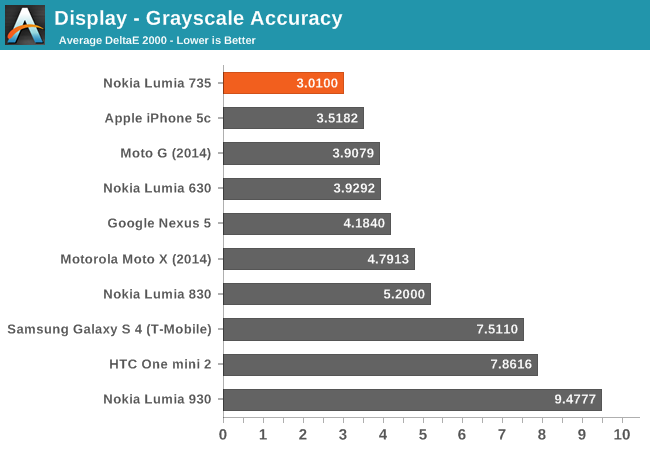
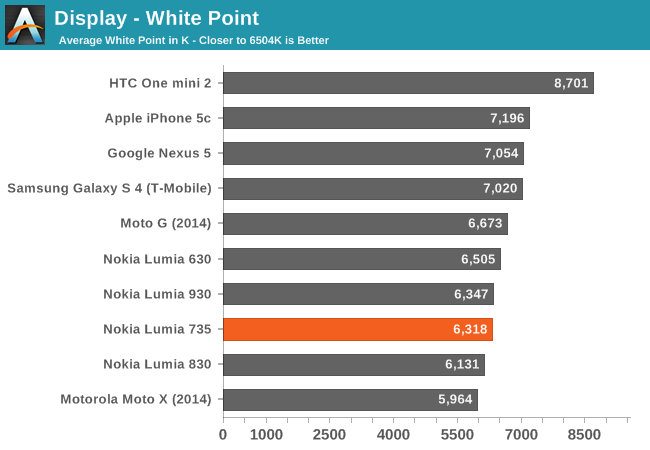

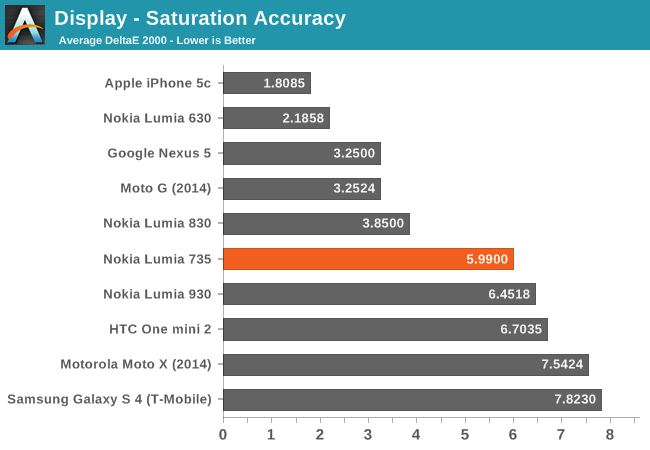

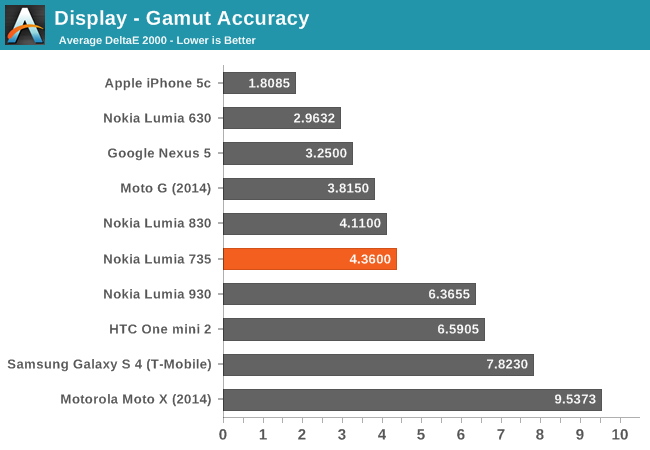

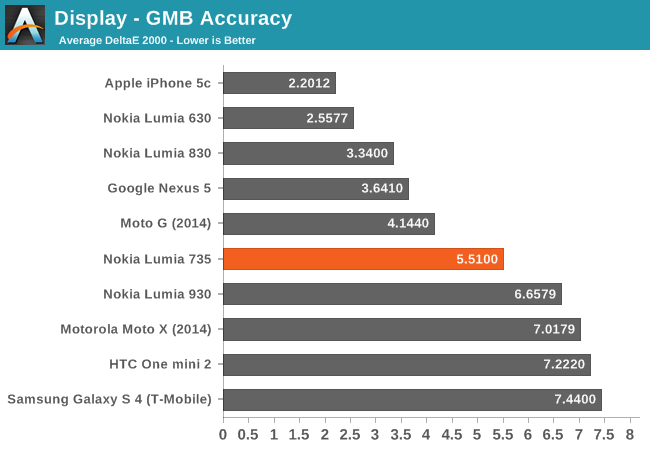








64 Comments
View All Comments
kspirit - Tuesday, February 3, 2015 - link
Brett, I applaud you for reviewing all the new Lumias here on AT. Thank youAlso I maintain this is a more interesting phone than the 830, given the price points for both.
Flame me.
Brett Howse - Tuesday, February 3, 2015 - link
Thank you for the kind words, and I won't flame you.iAPX - Tuesday, February 3, 2015 - link
I think that the Lumia line-up is a little weird, but there are many options and I would consider them when it will be time to replace my smartphone (basic usage, but a lot of music to store, for example on a micro-SD card, and tethering for my tablet).I think Nokia have done a great job to differenciate their products from the Android crowd, at least physically, and Microsoft is following with affordable Lumia smartphones.
iAPX - Tuesday, February 3, 2015 - link
Addition: as a photographer, Optical Image Stabilization (OIS) is of no interest except for 135mm+ equivalent (35mm format) lenses. Not on wide-angle, not for capture the true life where people are moving, because you will have too long exposure time with clear and sharp environment and blurry people!My 2 cents!
Laxaa - Wednesday, February 4, 2015 - link
It is useful for low-light shots and video, though. But I do agree with the rest of your sentiment.bretpowell - Wednesday, February 11, 2015 - link
The Lumia series has not been very popular to consumer, even if you look on a consumer base review (like http://www.phonestop7.tk/ for example...) they're nowhere to be found. But with the latest Windows 8 incorporated...hope things would changeSushisamurai - Tuesday, February 3, 2015 - link
does "Battery Saver mode" really equate to "stop background sync" on the other platforms? i'd still assume windows would have a separate option in settings.Zizy - Tuesday, February 3, 2015 - link
Well, it stops non-essential tasks and background stuff. It isn't limited to sync.But it doesn't change performance by slowing down CPU or something like that.
I don't think you gain a lot by using battery saver during these rundown tests. It shows high gains mostly in light use.
mantikos - Tuesday, February 3, 2015 - link
It also stops checking for e-mail and wifi networks to conserve battery. You can of course manually do both.Alexvrb - Thursday, February 5, 2015 - link
Battery Saver is great for what it was designed for. Obviously it isn't going to help much if you're actively using your phone, but it really stretches the "in-pocket" time if you forgot or were otherwise unable to charge it.